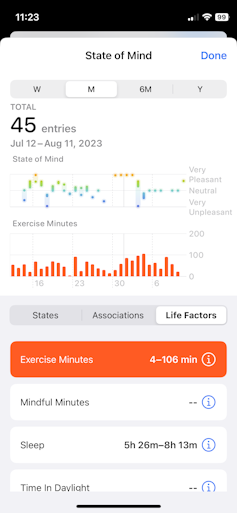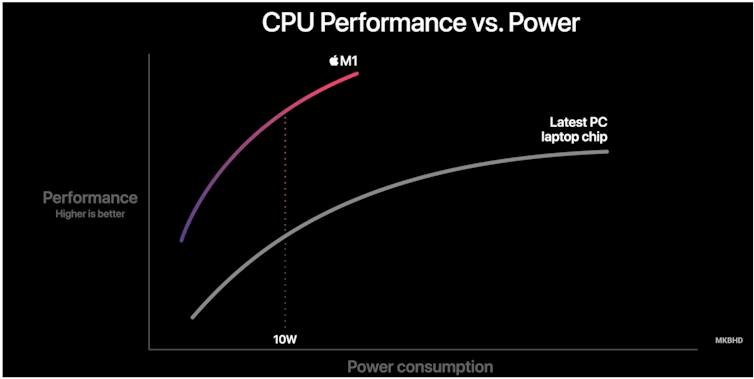When Apple’s latest software updates drop this month, users will have access to mental health and wellness features unlike anything currently available in a smartphone. With the Apple Watch and iOS health app, Apple has long striven to cement itself in the health-care tech space. But the new features go beyond the standard heart rate, sleep, calorie and fitness trackers that have become universal in smart tech.
A new mood tracker (dubbed “State of Mind”) will ask users to rate how they feel both in random moments (from unpleasant to pleasant) and daily. Mental health questionnaires will provide users with a preliminary screening for depression (using the PHQ-9 screening tool) and anxiety (using the GAD-7 screening tool) that can alert them to their risk levels and connect them to licensed professionals in their area.
Finally, Apple is introducing a journaling app that can collect user data from photos, texts, music/gaming/TV history, location, fitness etc. to give users a holistic picture of each day.
Those who use Apple’s ecosystem know that it’s extensive and powerful, and true Apple devotees will use an Apple product for nearly every digital experience they have.
This means Apple is in the position to arrive at unique insights about a user’s life. What they’re proposing in iOS 17 is to essentially hold a mirror up to their users, allowing them to see their lives through their interactions with technology.
Tracking mental state
As a philosopher of psychology who studies how technology is changing the way people relate to their mental health, and as an avid Apple fan, I wanted to try out these new features as soon as possible. I downloaded the public beta software in July and want to share my insights about how we might approach this new technology.
The State of Mind tool is simple to use. When opening the Health App after updating to iOS 17, I was prompted to start tracking my mental state. I can choose to log a state at a specific time (for example, how did I feel at 2:30 p.m. today?), or to log my mental state for the day.
The sliding scale of mental states is visually appealing. The screen turns blue when I slide to the “unpleasant” options and orange when I slide to the “pleasant” options.

After settling on a mental state, users are prompted to give some context.
First, there’s a predetermined list of emotions that might describe the user’s mental state (for example, “anxious,” “content,” “happy,” “excited”), and then a list of factors that might be contributing to that mental state (such as “work,” “friends,” “current events”). Here users can write in something specific that will be included in the log.
If they use it daily, users can access a calendar of daily mental states and a graph that visualizes the cycle of states over a given week, month or year. Clicking on any data point will pull up the details of that day, any momentary moods the user logged and the context the user provided.
The user interface functions similarly to the other health metrics Apple already logs. It is a minimalist design that offers easily digestible data. Users can access mental state metrics on the home screen of the app with their other health data.

When using the mental well-being features, I can’t help but think the introduction of them is a step closer to transhumanism, which is the amalgamation of humans and technology, and eventual replacement of the human body with technology.
Instead of just measuring physical fitness (tracking workouts, counting calories), the iPhone and Apple Watch can be holistic measures of me as a person. They can define not only my active life but also my mental life. I can scroll through an Apple-branded definition of who I am. Eventually, I can become the Apple ideal version of myself.
On the surface, it is helpful to see that I often rate days more highly when I’m active and sleep enough (although it doesn’t take AI to know that). However, as a researcher I know that there’s a limit to what data can tell us, based on the measurements we use and our biases as interpreters.
I wonder how the average Apple user will interpret this data, and whether they will start shaping their lives to arrive at graphs that look desirable.
The late philosopher Ian Hacking describes a looping effect between people and the labels they’re given. Looping effects are prominent in the algorithm-driven software we use. Researchers have found people’s TikTok feeds become reflections of their self-concept as they begin to trust the insights AI draws from the feedback they’ve given.
However, TikTok algorithms are not blank slates for self-concept creation. They’re designed to put people into marketing categories to sell them to advertisers.
Apple isn’t trying to sell your data; its privacy policy states, “Apple does not share personal data with third parties for their own marketing purposes.” But its health app reflects its corporate mandates and the world it wants to create.
In an interview with Time, Apple CEO Tim Cook said, “Apple’s largest contribution to mankind will be in improving people’s health and well-being.”
Apple is a company of ideals. Compared to traditional computer marketing, which highlights performance specs, Apple pioneered selling computers by advertising who a user can be with a Mac. This was the purpose behind their “Think Different” campaign. Even when Apple does discuss technical details of computer performance, their use of flashy visuals and vague language makes it difficult to accurately assess their products against competitors.

The messaging is clear: An Apple user is not just someone who owns a piece of tech, but someone who is cool, creative, colourful and individualistic. Now they can be healthy and well-adjusted, too.
But corporate mandates can be hollow because at their core they exist to increase profits. Apple’s success as a company comes from its ability to own the consumer.
With an airtight ecosystem, users become dependent on Apple for all their digital needs. By integrating health into that ecosystem, those users may be dependent on Apple for their well-being too. I’m not sure what happens when people incorporate their Apple self into their self-concept, but it might make them better consumers and more productive employees. Ultimately, this is the goal of corporate mental health.
Just as spa days and five-minute yoga breaks can only go so far in improving mental health, it’s not clear that iOS 17 is the medical revolution Apple hopes it will be.
